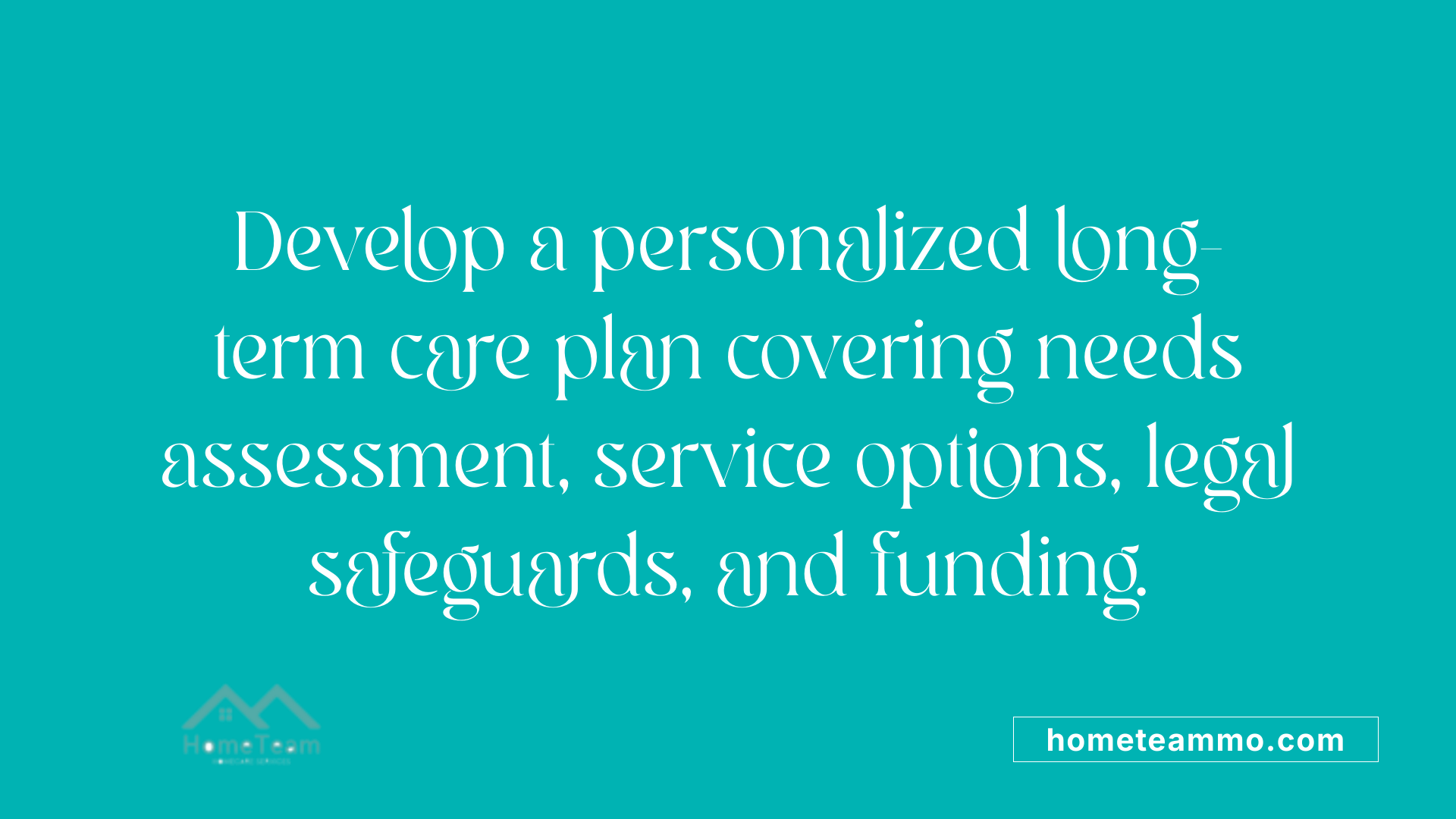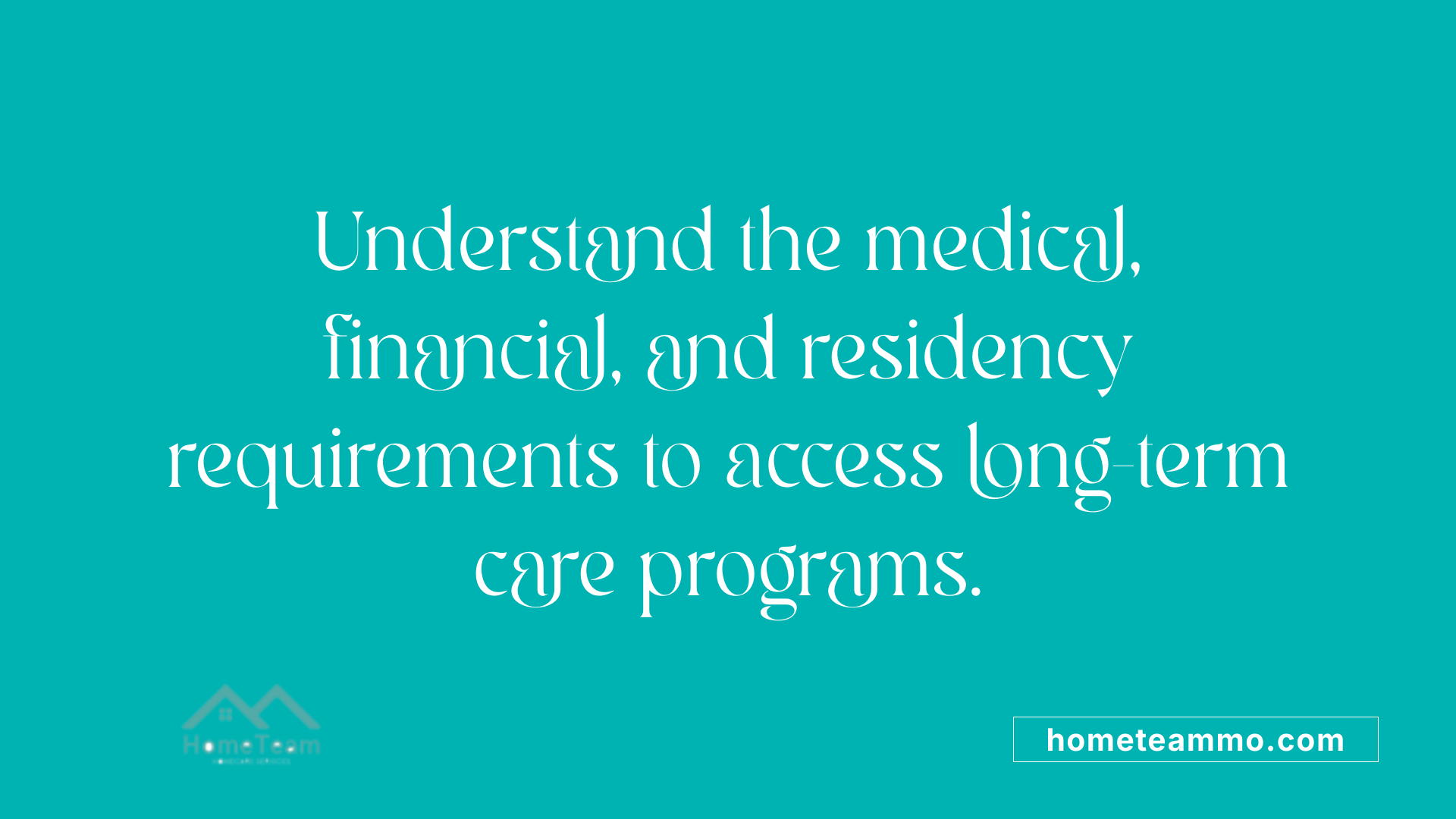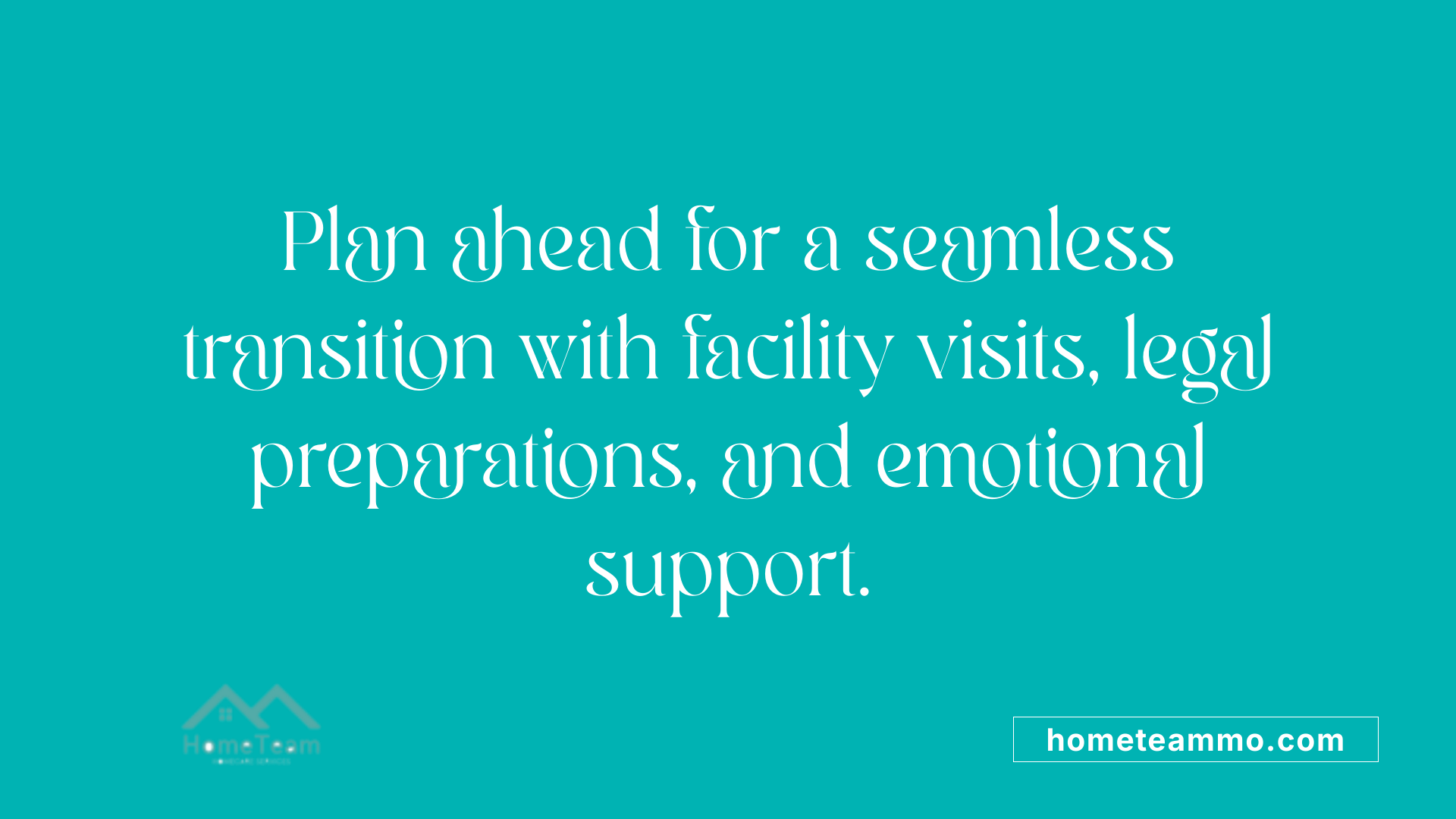How to Plan for Long-Term Home Care Services
keys to successful long-term care planning for home services

Understanding the Foundations of Long-Term Home Care Planning
Planning for long-term home care is a proactive process that ensures individuals receive the necessary medical and personal support as they age or face health challenges. This process involves evaluating current needs, exploring various service options, and establishing financial and legal arrangements that align with personal preferences. Beginning early and engaging in comprehensive planning strategies can greatly enhance quality of life, promote independence, and reduce stress for families.
Core components of a comprehensive long-term care plan

What are the core components of a comprehensive long-term care plan?
Creating a thorough long-term care plan involves multiple essential elements aimed at ensuring a person's health, independence, and preferences are maintained over time.
First, it is vital to assess current and future care needs. This includes evaluating health status, mobility, cognitive function, and specific personal care requirements. Understanding these factors helps in identifying which services will be necessary as needs evolve.
Next, exploring available long-term care services is crucial. Options range from in-home care, where informal caregivers like family and friends may assist with daily activities, to formal services such as adult day care, assisted living facilities, or nursing homes. Researching these options allows individuals to choose the most appropriate setting that aligns with their preferences and needs.
Financial planning is another cornerstone of a solid long-term care strategy. This involves reviewing savings, considering long-term care insurance policies, and utilizing government programs like Medicaid and Medicare. Establishing a dedicated source of funding helps cover costs that can be substantial, such as nursing home stays or assisted living fees.
Legal considerations are fundamental to protect individual wishes and ensure smooth decision-making. Setting up legal documents like powers of attorney, healthcare proxies, and living wills ensures that trusted persons can make decisions on one's behalf and that medical treatments align with personal preferences.
Engaging professionals such as elder law attorneys, financial advisors, and elder care planners can provide expert guidance tailored to specific situations. Their advice can inform legal, financial, and care arrangements, making the plan more robust.
Finally, a comprehensive plan requires regular review and updates. As circumstances change—such as shifts in health, finances, or family situations—adapting the plan ensures it remains relevant and effective. Ongoing communication with loved ones and care providers facilitates adjustments and helps everyone stay informed.
In summary, an effective long-term care plan comprehensively addresses care needs, explores service options, secures funding, incorporates legal safeguards, involves professional guidance, and stays flexible through continuous updates. This proactive approach ensures quality of life and peace of mind for individuals and their families.
For more detailed guidance, search terms like "comprehensive long-term care planning guide" can provide additional resources and tools.
Types of long-term care facilities and services

What are the different types of long-term care facilities and services?
There are several options available to meet the varying health and support needs of aging individuals or those with disabilities. Each type of long-term care facility offers different levels of assistance, medical support, and independence.
Nursing homes, also known as skilled nursing facilities, provide round-the-clock medical care, rehabilitation services, and assistance with daily activities like bathing, dressing, and medication management. They are designed for residents with complex medical conditions or those recovering from illness who require intensive medical supervision.
Assisted living facilities offer a more independent living arrangement combined with support services such as help with personal care, meals, housekeeping, and social activities. These facilities are suitable for individuals who need some help but wish to maintain a level of independence and participate in community life.
Continuing Care Retirement Communities (CCRCs) integrate different levels of care—such as independent living, assisted living, and skilled nursing—within one campus. This setup allows residents to transition seamlessly between services as their health needs evolve, providing a continuum of care without moving to a new location.
In-home and community-based services enable individuals to receive assistance while remaining in their own homes. This support can include personal care, meal delivery, adult day care, and home health services like nursing and therapy. These options promote aging in place, fostering independence and comfort.
Exploring these options early and understanding the differences can help families plan effectively for future care needs and match preferred living arrangements with their health status and lifestyle preferences.
Eligibility criteria and application processes

What are the eligibility criteria for long-term care programs?
Eligibility for long-term care services hinges on several factors. A primary requirement is demonstrating a medical need, typically verified by a healthcare professional, which involves assistance with Activities of Daily Living (ADLs) such as bathing, dressing, eating, or mobility. For programs like Medicaid, applicants must usually meet specific health criteria that indicate a need for nursing-level care.
Financial eligibility plays a significant role. Most programs have income and asset limits designed to target those with limited resources. For example, many states set asset limits around $2,000, excluding certain essential assets like a primary residence, personal belongings, and one vehicle. Income thresholds vary but often align with federal or state Medicaid standards.
Residency and domicile are also required. Applicants typically need to reside within the state offering the program or in approved settings, whether in the community or a facility. Proof of legal residence is necessary to qualify.
Specific program rules influence eligibility. Medicaid, for instance, requires applicants to meet medical criteria—such as needing a nursing home level of care—and may involve participating in a mandatory medical assessment. Medicare eligibility, on the other hand, depends on age (65+) or specific disabilities, with coverage limited mainly to short-term care and hospitalization-related services.
When it comes to financial transfers, many programs enforce a look-back period—commonly five years—to prevent asset transfer or gift-giving intended to qualify for assistance. Assets transferred during this period may lead to a penalty period of ineligibility.
Special considerations are in place for spouses and household members. For example, protections exist to prevent complete asset depletion of a spouse’s resources, often allowing for spousal income and asset safeguards that maintain the household’s financial stability.
Overall, each program has tailored criteria that applicants must meet, often involving a combination of medical documentation, financial status, residency proof, and compliance with specific rules regarding resource transfer and household circumstances.
Exploring these criteria through resources like state Medicaid offices, elder law attorneys, and caregiving agencies can help applicants understand their options and navigate the application process effectively.
For more detailed guidance, search for “long-term care eligibility criteria and application process.” This will provide tailored information based on your location and specific needs, ensuring a comprehensive understanding of qualification requirements.
Financial and legal planning strategies
How can I plan financially and legally for long-term care needs?
Early planning for long-term care involves understanding the total costs, which can average around $7,000 to $8,000 per month for services like nursing homes or assisted living. To prepare financially, it’s important to explore various funding options, including personal savings, investments, and estate planning tools such as trusts.
Long-term care insurance is another valuable resource that helps cover expenses not paid by traditional health insurance. It’s advisable to consider purchasing coverage early, when premiums are lower and health conditions are better.
Government programs like Medicaid and Veterans’ benefits can also significantly offset costs. Medicaid, for example, covers over half of nursing home expenses in many states, but eligibility depends on income and assets. Proper planning includes legal documents like wills, durable powers of attorney, healthcare proxies, and living wills, which ensure your care preferences are respected and assets protected.
Working with elder law attorneys or financial advisors is crucial to craft a comprehensive and personalized plan. They can help coordinate public benefits with private insurance, safeguard assets, and prevent elder abuse, providing peace of mind for your future.
By starting early and consulting professionals, you can develop a robust plan that balances health, financial security, and legal considerations to meet your long-term care needs effectively.
Transitioning into long-term care - planning for a smooth move
 Moving into long-term care can be a significant change for seniors and their families. The process begins with a thorough assessment of the individual’s needs, health status, and ability to manage daily activities. This helps determine the most suitable care setting, whether it is an assisted living facility, nursing home, or in-home care.
Moving into long-term care can be a significant change for seniors and their families. The process begins with a thorough assessment of the individual’s needs, health status, and ability to manage daily activities. This helps determine the most suitable care setting, whether it is an assisted living facility, nursing home, or in-home care.
Involving loved ones in decision-making is vital. Discussing preferences, concerns, and the type of care desired ensures that the choices made align with the individual’s wishes and lifestyle. Early conversations about future plans can ease anxiety and foster cooperation.
Preparing emotionally and practically for the move is equally important. Caregivers should prepare the individual by visiting potential facilities, which allows them to get familiar with the environment. Packing items that are meaningful or comforting can make the new space feel more like home.
Conducting tours of facilities or homes provides a valuable opportunity to assess the quality of care, safety features,Staff support and social activities. Asking questions about staff-to-resident ratios, medical services, and daily routines helps ensure the chosen setting meets specific needs.
Legal and financial preparations should be completed beforehand. This includes updating legal documents like powers of attorney, living wills, and guardianship arrangements. Financially, it is essential to review options for funding care, including insurance, Medicaid, or savings, and to understand costs involved.
Support strategies to aid physical and emotional adjustment include familiarization visits, establishing routines, and maintaining social connections. Regular communication with staff and family members helps the individual feel supported and involved.
Succinct planning and compassionate support are instrumental in making the transition as seamless as possible, reducing stress and promoting well-being during this important life change.
Key Takeaways for Effective Long-Term Care Planning
Proactively preparing for long-term home care by understanding your options, planning finances and legal documents, assessing needs, and involving professionals and loved ones creates a pathway toward maintaining independence and ensuring quality care. Starting early and regularly reviewing your plan will help you adapt to changing circumstances, ultimately providing peace of mind and safeguarding your future well-being.
References
- A Caregiver's Guide to Long-Term Care Planning
- What Is Long-Term Care? | National Institute on Aging
- Long Term Home Health Care Program
- Long Term Care Coverage - Medicare
- How to Plan for Long-term Care | SALMON Health and Retirement
- Long Term Care - Home Care Services Program - NYC.gov
- What Is Long-Term Care Planning? - SmartAsset
- Long-Term Care: Advice & Resources from AARP
- Managed Long Term Care (MLTC)
- 11 Tips To Plan Your Long-Term Care Needs After Retirement

How Home Team Helps Families Make Informed Care Decisions

How Home Team's Caregivers Provide Peace of Mind for Families

Mobility Support: Safe Transfer and Lifting Techniques



